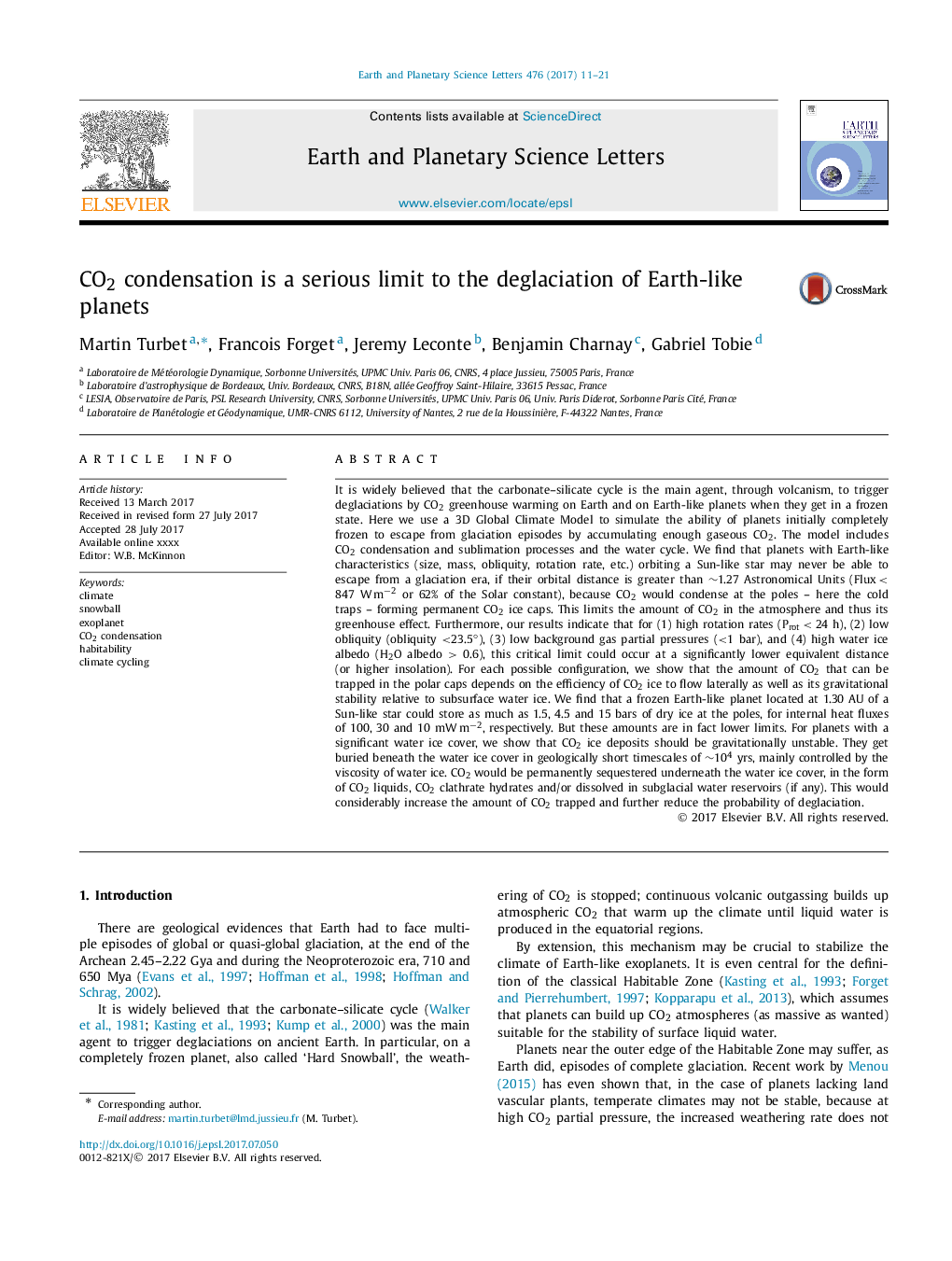| کد مقاله | کد نشریه | سال انتشار | مقاله انگلیسی | نسخه تمام متن |
|---|---|---|---|---|
| 5779631 | 1634680 | 2017 | 11 صفحه PDF | دانلود رایگان |
عنوان انگلیسی مقاله ISI
CO2 condensation is a serious limit to the deglaciation of Earth-like planets
دانلود مقاله + سفارش ترجمه
دانلود مقاله ISI انگلیسی
رایگان برای ایرانیان
موضوعات مرتبط
مهندسی و علوم پایه
علوم زمین و سیارات
علوم زمین و سیاره ای (عمومی)
پیش نمایش صفحه اول مقاله

چکیده انگلیسی
It is widely believed that the carbonate-silicate cycle is the main agent, through volcanism, to trigger deglaciations by CO2 greenhouse warming on Earth and on Earth-like planets when they get in a frozen state. Here we use a 3D Global Climate Model to simulate the ability of planets initially completely frozen to escape from glaciation episodes by accumulating enough gaseous CO2. The model includes CO2 condensation and sublimation processes and the water cycle. We find that planets with Earth-like characteristics (size, mass, obliquity, rotation rate, etc.) orbiting a Sun-like star may never be able to escape from a glaciation era, if their orbital distance is greater than â¼1.27 Astronomical Units (Flux<847Wmâ2 or 62% of the Solar constant), because CO2 would condense at the poles - here the cold traps - forming permanent CO2 ice caps. This limits the amount of CO2 in the atmosphere and thus its greenhouse effect. Furthermore, our results indicate that for (1) high rotation rates (Prot<24h), (2) low obliquity (obliquity <23.5°), (3) low background gas partial pressures (<1 bar), and (4) high water ice albedo (H2O albedo > 0.6), this critical limit could occur at a significantly lower equivalent distance (or higher insolation). For each possible configuration, we show that the amount of CO2 that can be trapped in the polar caps depends on the efficiency of CO2 ice to flow laterally as well as its gravitational stability relative to subsurface water ice. We find that a frozen Earth-like planet located at 1.30 AU of a Sun-like star could store as much as 1.5, 4.5 and 15 bars of dry ice at the poles, for internal heat fluxes of 100, 30 and 10 mWâmâ2, respectively. But these amounts are in fact lower limits. For planets with a significant water ice cover, we show that CO2 ice deposits should be gravitationally unstable. They get buried beneath the water ice cover in geologically short timescales of â¼104 yrs, mainly controlled by the viscosity of water ice. CO2 would be permanently sequestered underneath the water ice cover, in the form of CO2 liquids, CO2 clathrate hydrates and/or dissolved in subglacial water reservoirs (if any). This would considerably increase the amount of CO2 trapped and further reduce the probability of deglaciation.
ناشر
Database: Elsevier - ScienceDirect (ساینس دایرکت)
Journal: Earth and Planetary Science Letters - Volume 476, 15 October 2017, Pages 11-21
Journal: Earth and Planetary Science Letters - Volume 476, 15 October 2017, Pages 11-21
نویسندگان
Martin Turbet, Francois Forget, Jeremy Leconte, Benjamin Charnay, Gabriel Tobie,